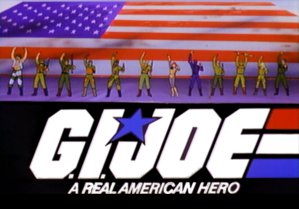When Hasbro launched the
G.I. Joe: A Real American Hero toyline in 1982 alongside the
Marvel Comics series, it commissioned
Marvel Productions to produce a series of fully animated 30-second television commercials which were broadcast in order to promote the comic book publication, since advertising regulations for a literary work were more lax than for a direct toy commercial.
[8] The commercial for the first issue began airing throughout the Spring of 1982.
[9] The popularity of these commercials led to the production of a five-part
G.I. Joe mini-series which aired in 1983 (later titled "The M.A.S.S. Device" when it re-aired as part of the ongoing series). The plot centers on the titular M.A.S.S. Device, a powerful matter-transporter, and G.I. Joe and Cobra's race around the world to acquire the three catalytic elements which power the machine. A second five-part mini-series followed in 1984,
G.I. Joe: The Revenge of Cobra (titled "The Weather Dominator" in later airings), with a similar plot that involved the Joes and Cobras traveling around the world to recover the scattered fragments of Cobra's new weather-controlling weapon, the Weather Dominator. Both mini-series were written by
Ron Friedman.
G.I. Joe was promoted to a full series in 1985, with an initial order for a first season of 55 more episodes (in order to make up the required 65 episodes for syndication).
[10] This season began with a third Friedman-penned five-part adventure, "The Pyramid of Darkness"; the story sees most of the existing cast from the two previous mini-series held captive by Cobra, while a new assortment of characters (that is, the new 1985 range of toys) thwart Cobra's attempts to surround the Earth with the electricity-negating Pyramid of Darkness. Both the new and old characters then shared the spotlight throughout the course of the remaining fifty episodes of the series, which were primarily stand-alone single-episode adventures, with the occasional two-part story.
).


 (It just wasn't done on American cartoons at the time.)
(It just wasn't done on American cartoons at the time.)